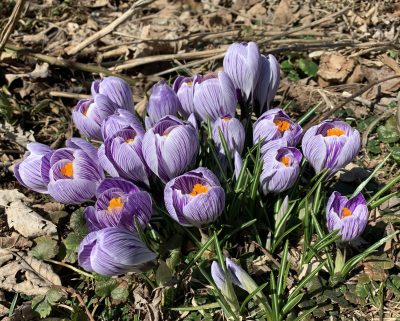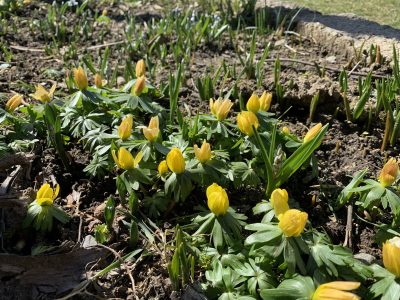COVID-19 OR NOT, THE GARDEN MARCHES ON
/11 Comments/in Gardening, Vegetables/by Lee ReichA Special Week
Coronavirus has come, and it will go, but the natural world soldiers on. My dogs, Sammy and Daisy, are as happy as ever, oblivious to the pandemic. My garden will respond likewise, trucking forward and offering a centering point as the world around has its ups and downs.
This week is a very special one in my gardening year; it’s the week I plant peas. April 1st, to be specific. It’s sort of the official beginning of the vegetable garden. “Sort of” because actually have been planting and harvesting lettuce, mâche, arugula, claytonia, kale, bok choy, chard, and celery all winter in the greenhouse.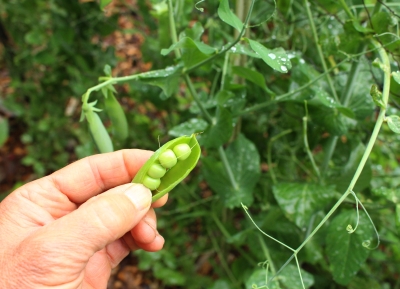
Not Too Early, Not Too Late
For some gardeners, St. Patrick’s Day is the date for sowing peas. Yes, that is the correct date for pea sowing — in Ireland, Virginia, and other places where I imagine soil temperatures reach about 40° F by that date. Above 40° F, and pea seeds become most likely to sprout rather than rot. On the other hand, waiting too long to plant pea seeds has the plant bearing during hot weather; peas don’t stand the heat well.
I mostly plant shelling peas, which are admittedly more trouble because they need shelling. To me, they’re worth it, for their flavor. (Then again, with the pandemic, more people are spending more time at home; gather ‘round and let’s shell peas.) I recommend the very tasty varieties Green Arrow and Lincoln.
My pea plants grow right up the center of 3-foot-wide beds. I make two furrows a couple of inches deep, one on either side of a bed’s center, and 4 inches apart. The seeds go in a couple of inches apart.
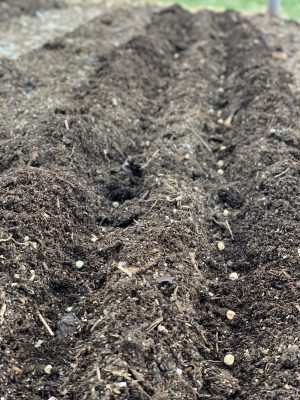
Pea plants are sometimes available as transplants, or, as my neighbor used to call them, “starts,” in cell-packs. Don’t buy them. Peas are a vegetable for which you sow the seeds directly in the garden. The reason is that the yield from a single plant, even six plants in a cell-pack is too minuscule to be worth it. And pea seeds sprout readily. Have some faith.
Once seedlings poke up through the ground surface, I put a trellis up the middle of the row. My trellis is temporary, able to move around the garden, just as do the pea plants, to a different bed each season. I pound a metal post into the ground at each end of the row, and then weave 3 foot high poultry netting (“chicken wire”), inch-and-a-half mesh, onto the posts. I use fiberglass electric fence posts, but any thin stakes woven at intervals into the netting and pushed into the ground keeps the fence from being floppy. After the final harvest, I pull up the pea plants, pull up the thin stakes, remove and roll up the netting, and pull up the end posts for use next year.

A number of other seeds can be planted on that seminal (for here) April 1st pea planting date. Those would include, except celery, the vegetables I mentioned above that have been growing in the greenhouse all winter. Radishes could also be included here, and spinach. And potatoes, as 2 ounce, whole tubers or pieces of cut tubers.
Best Tomatoes For . . . ?
Also significant about April 1st on my gardening calendar is that it’s my date to sow tomato seeds, indoors in seed flats. It’s not that tomato is my favorite garden vegetable; it’s just that it’s such a popular vegetable and perhaps the most versatile.
For a cherry tomato to just pop right in my mouth or put in salads, I grow Sungold. That’s all they’re good for, but they’re really, really good for that.

I dry many varieties, especially Amish Paste and Anna Russian. Some of them also go into jars, along with San Marzano, arguably the best tasting tomato for canning. (In Italy, cans of tomato made with San Marzano tout that on the label.) Blue Beech is another variety, this one with a unique flavor, that I both can and dry.

For good, fresh eating and very pretty tomatoes, I’m growing Nepal, Carmello, and, with a bright orange skin, Valencia. All three varieties are round tomatoes with smooth, crack-free skins.
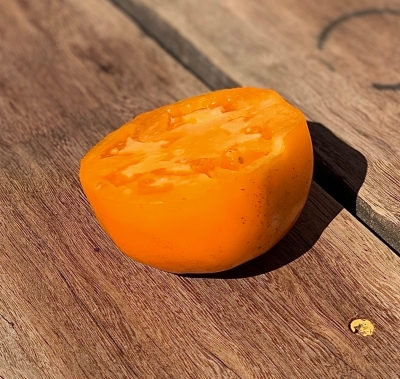
Valencia tomato
For the very best in fresh eating tomatoes, there are many to choose from. I’m growing Paul Robeson and Pink Brandywine this year, although many others, such as Belgian Giant, Cherokee Purple, or others with “Brandywine” in their name could also fill the bill. Extras of these and the previous mentioned “good, fresh eating” varieties go into sauce, but not, of course, the dedicated San Marzano batches. Besides being good for cooking and drying, Amish Paste and Anna Russian are also good fresh. Not San Marzano, though; it’s awful raw.
As with pea planting, my tomato-sowing date is not for everyone; what is for everyone is to sow the seeds about 6 weeks before the local “average date of the last killing frost,” a date that is available online or from the local County Cooperative Extension Office. Sowing on this date strikes a nice balance between plants being small enough to make a smooth transition out to the garden and being sufficiently large for a timely first harvest.
April 1st isn’t the date to start all transplants. I sowed onion seeds way back in early February, and pepper and eggplant seeds in early March. For an early crop of cucumbers or melons, I’ll sow those in early May for transplanting at the end of the month. Or I’ll plant the seeds directly in the ground sometime soon after the “last killing frost” date. (I made a whole chart of vegetables and garden sowing, indoor sowing, and transplanting dates, keyed to whatever anyone’s “last frost date” is, in my book Weedless Gardening.)
Take Care
The garden marches smoothly forward, snubbing its nose at the pandemic. We can do likewise if we stay home if possible, wash our hands frequently and thoroughly and keep them away from our faces, and protect ourselves and others if we must go out. Consider that everything you touch off-site could be contaminated, or could be made so by you.
VEGETABLE MATTERS
/12 Comments/in Gardening, Soil, Vegetables/by Lee ReichHomebound? Plant Vegetables!
Working from home, I’m used to being homebound. And I like it. Not everyone feels this way, and now COVID-19 has forced this situation on many people.
For anyone who isn’t growing some vegetables, if there ever was a time to start a vegetable garden, it’s now.
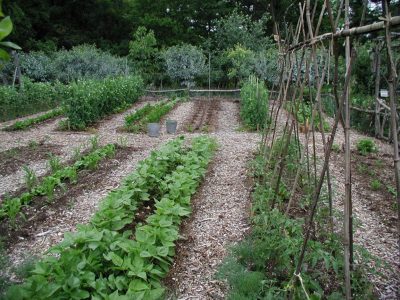
A garden will provide pleasant and interesting diversion, some exercise, a chance to be outdoors, the need for less frequent trips to the market, a good family project/activity, and some savings of food dollars. And the experience of — wonder of wonders — watching seeds sprout and grow into plants.
Growing vegetables is easy. Seeds have been practicing sprouting for millions of years. That’s what they do. Sprout. And plants have been doing likewise.
Paying attention to some basic plant needs will make your garden even more successful. As far as soil, don’t worry about fertility or acidity for now. The most important consideration is drainage. That is, does water move down through the soil or does it just sit in place for a long, long time.
What’s a “long, long time?” If you really want to know, cut the bottom and top off a coffee or similar can, and set the can into a hole a few inches deep, pushing it into the soil (not if it’s frozen) in the bottom of the hole. Fill the can with water, let it drain, then fill it again. If the water level drops slower than 1” per hour, drainage is poor. Find another site or make raised beds.
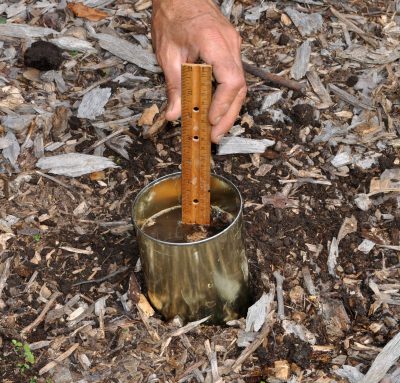
No backyard or front yard in which to grow vegetables? No problem. Grow them in a tub or flowerpot. Pay attention to drainage even if your “garden” is a tub or a large flowerpot. The container must have drainage holes in its bottom to let water drain out. And you’re going to fill that container with “potting soil,” not with dirt from your garden. Water can’t drain well through garden soil in the confines of a container, which is why potting soils have, among their ingredients, perlite, vermiculite, or other mineral aggregate to speed water flow.
Whether in a container or in your front or back yard, vegetables need sun, about 6 hours of direct summer sunshine daily.
Soil Matters
Next, ready the ground. For most newbies, that means transmuting a patch of lawn to a vegetable garden. There are two options. The first is the traditional one, turning over and mixing up the top few inches of ground to kill existing vegetation and leave a surface in which you can plant seeds. Do that, using a shovel, garden fork, or rototiller as soon as the soil is dry enough to crumble, not wad up, when squeezed gently in your hand.
 Wait two weeks for Mother Nature to work her magic decomposing some of that existing vegetation. Or, rather, part of her magic. After two weeks, dig up the ground again, this time adding some compost or fertilizer. You could dispense with the compost or fertilizer this season if whatever was growing there before digging looked vibrant. Better not to go out to a store these days if you don’t have to anyway. Wait another two weeks, and when you’re ready to plant, use a garden rake to tickle the surface of the ground and crumble it.
Wait two weeks for Mother Nature to work her magic decomposing some of that existing vegetation. Or, rather, part of her magic. After two weeks, dig up the ground again, this time adding some compost or fertilizer. You could dispense with the compost or fertilizer this season if whatever was growing there before digging looked vibrant. Better not to go out to a store these days if you don’t have to anyway. Wait another two weeks, and when you’re ready to plant, use a garden rake to tickle the surface of the ground and crumble it.
Digging up the ground may be a nice way to get your blood pumping on a spring day, and may even give you a feeling of righteousness, but there’s a better, quicker, and easier way, to prepare the garden site. There’ll also be less weeds in weeks to come.
For option number two, you will need a supply of compost and either wood chips, straw, sawdust, or wood shavings. This option is easy: just cover the garden area with newspaper, four sheets thickness and overlapping, and then wet the newspaper to keep it from blowing away. Mark out 3 foot wide beds and 18 to 24” wide paths with string, and lay an inch or more of compost in the bed areas, and enough of the wood chips, straw, sawdust, or wood shavings in the paths to cover the paper. You’re all set to plant!
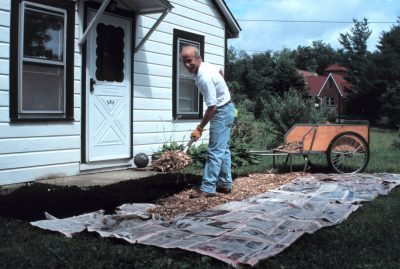
In most places, but not everywhere, a fence is needed to fend off rabbits. Two-foot high chickenwire (“poultry netting”) will do the trick.
(All this, and more, in my book Weedless Gardening.)
What to Grow
What to grow is a matter of taste. Kale, collards, and Swiss chard offer maximum nutrition and a very long harvest season. For some home-grown calories, potatoes and sweet corn. For rounding things out with great flavor, tomato, eggplant, pepper, cucumbers. Think about what you want to grow, look at seed catalogues, order seeds, and when we next cross paths, I’ll say something about timing.
Inspiration and Humor for the Pandemic
In these times of pandemic, the insouciance of animals and the humor they offer (and washing hands, social distancing, and covering up coughs and sneezes) is welcome. Here is a short video clip of my ducks:
Duck video
NOW, WITH COVID-19, ANOTHER REASON TO GARDEN
/19 Comments/in Gardening/by Lee ReichNot Necessarily Anti-Social
I’m feeling very lucky these days, lucky to be happy to stay home. An important way to deal with the current COVID-19 pandemic, both from a personal and a societal standpoint, is not to be out and about.
(If you are infected, you may not show any symptoms for awhile, or symptoms may be very mild. During that time, though, you could infect others. It’s estimated that, at present, every infected person infects 3 others before they get well or die. Those 3 other each infect 3 more, and so on; ten transmissions has almost 60,000 people infected.
Social distancing brings that number of 3 new infections from each infected person down to a number of cases our health care system would be able to handle. So stay at home, if possible, maintain a six foot distance from other humans, be aware of contaminated objects and surfaces, and wash hands frequently.)
For all the downsides of the internet, a big plus now is the ability it gives us to interact socially without spreading disease.
Home is Nice, Gardening
What’s so great about staying home? In my case, I have my garden, of course. Spring, as always, is a busy time in the garden.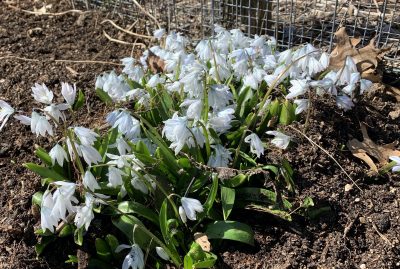 Busy, such as: attending to my compost. The last compost pile of late fall and winter is an accumulation of end-of-season debris from garden cleanup, bedding from the duck house, and kitchen scraps. Not much happens in it with the slow additions and winter cold. I decided to dig into the pile to see how it was doing. Not good!
Busy, such as: attending to my compost. The last compost pile of late fall and winter is an accumulation of end-of-season debris from garden cleanup, bedding from the duck house, and kitchen scraps. Not much happens in it with the slow additions and winter cold. I decided to dig into the pile to see how it was doing. Not good!
The innards were smelly and sodden, which could have been avoided if I had regularly thrown some straw, autumn leaves, or any other dry, old plant matter into it periodically. Oh well.
Given enough time, even that smelly, cold, sodden pile would turn to compost. I prefer to speed things up, getting the pile hot and quickly killing many weed seeds.
Aeration and some dry material could remedy the situation. I left home and got a load of horse manure mixed with dryish sawdust bedding from a nearby stable. (No human contact was needed to get the manure). Then I began turning the pile, layering in the manure and some old hay that I had cut and raked last fall. The way I tell how its doing is by taking its temperature with a long-stemmed compost thermometer. Three days after the turning, the pile is warming, 90° and rising.
Seed Starting, When?
Busy, such as: starting seedlings indoors for later planting outdoors. The ideal is to have seedlings the right size when it’s time for that outdoor planting, so they can make a smooth transition from container to ground hardly knowing they’ve been moved. Each vegetable has its own timetable for how fast it grows to transplant size and then when it can be planted outdoors.
For instance, here on the farmden, the historical average date of the last killing frost is May 21st. Cabbage seedlings need about 6 weeks of growth before they’re large enough to transplant. Since they tolerate some cold, they can be planted out here on May 1st. Six weeks before May 1st is March 15th, which is when I sowed those seeds.
Let me also use tomato as an example because that’s one that many gardeners plant too early or too late. Tomato seeds need about 7 weeks of growth before they’re ready to plant out. Freezing temperatures are not good for them, so I plant them out around the end of May. The end of May minus 7 weeks is around April 1st, which is when I’ll be sowing tomato seeds.
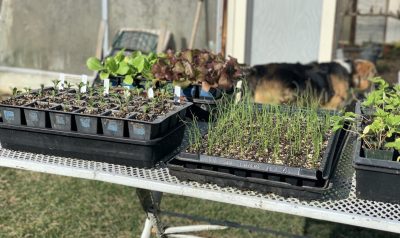
Sowing and planting dates are not set in stone. Temperature, potting mix, and container size all influence how fast seedlings grow. And there’s wiggle room because sowing or planting out tomatoes a week earlier or later doesn’t change the date of the first harvest that much because plants grow slowly early in the season.
One thing to avoid is being pushed around too much by the weather. Don’t let a 3 day warm spell in March convince you to sow tomatoes then, or a 3 day warm spell in early May to plant out tomatoes earlier. In the first case, the plant, being too large at transplant time, will have a harder transition to open ground; you’ll harvest earlier tomatoes, but less over the whole season. In the latter case, a subsequent cold spell might kill the plants (unless you cover them for protection).
I detail out recommended sowing and planting dates for vegetables according to locale in my book Weedless Gardening. At the very least, write down what you do in your garden this year and tweak it closer and closer each season.
Planting, What?
Busy, such as: planting out new trees, shrubs, and vines. After so many years here at the farmden, you’d think that I would have planted every tree, shrub, or vine I could have wanted. Tain’t so.
I’m very specific about what varieties I want to plant so I usually order bare root plants, which are available in greater variety than potted plants. Ideal size for a tree is about 4 feet high because their roots can establish in their new home quickly. Of course, a potted plant, if that variety is available locally, would establish even more quickly.
In the pipeline this year are Egremont Russet and Rubinette apples, Dr. Goode grape, Mohler persimmon, and a number of low bush blueberries and lingonberries.
I remember a sunny day years ago, right after hurricane Irene. The back part of my property, where my vegetable gardens are, was high and dry, a glorious early fall day. But turning 180 degrees, looking to the front, the Wallkill River and associated flood debris was flowing past my doorstep. These days, my thoughts are often on COVID-19. Again, the garden — or a hike in the woods and other home enjoyments — provide needed respite from a bad situation.
